Porter-Cable NS150C Handleiding
Porter-Cable
Nietmachine
NS150C
Bekijk gratis de handleiding van Porter-Cable NS150C (6 pagina’s), behorend tot de categorie Nietmachine. Deze gids werd als nuttig beoordeeld door 69 mensen en kreeg gemiddeld 4.4 sterren uit 35 reviews. Heb je een vraag over Porter-Cable NS150C of wil je andere gebruikers van dit product iets vragen? Stel een vraag
Pagina 1/6

A. Trigger
Détente
Gatillo
B. Contact trip
Déclencheur par contact
Activador por contacto
C. No-mar pad
Appui antimarques
Protector anti-rayadura
D. Low nail indicator window
Fenêtre indicatrice de recharge
Ventana indicadora del nivel de
clavos
E. Magazine
Chargeur
Fuente
F. Magazine Release
Mécanisme de dégagement
du chargeur
Liberador del resorte propulsor
G. Air Inlet
Port d’admission d’air
Entrada de aire
H. Rear exhaust
Échappement arrière
Escape trasero
I. Adjustable belt hook
Crochet de ceinture réglable
Sujetador para el cinturón ajustable
J. Depth adjustment wheel
Molette de réglage de profondeur
Rueda de ajuste de la profundidad
Actuating tool may result in flying debris,
collation material, or dust which could harm
operator’s eyes. Operator and others in work
area MUST wear safety glasses with side
shields. These safety glasses must conform to
ANSI Z87.1 requirements (approved glases have
“Z87” printed or stamped on them). It is the
employer’s responsibility to enforce the use of
eye protection equipment by the tool operator
and other people in the work area. (Fig. A)
and other protection during use. Under some
conditions and duration of use, noise from this
product may contribute to hearing loss. (Fig. A)
Conden sation
from an air compressor can rust and damage the
internal workings of the tool. (Fig. B)
Use air pressure
compatible with ratings on the nameplate of
the tool. [Not to exceed 120 psi (8.3 bar).] Do not
connect the tool to a compressor rated at over
175 psi. The tool operating pressure must never
exceed 175 psi even in the event of regulator
failure. (Fig. C)
Only use an air hose that is rated for a
maximum working pressure of at least 150 psi
(10.3 bar) or 150% of the maximum system
pressure, whichever is greater. (Fig. D)
Bottled compressed gases such as oxygen,
carbon dioxide, nitrogen, hydrogen, propane,
acetylene or air are not for use with pneumatic
tools. Never use combustible gases or any other
reactive gas as a power source for this tool.
Danger of explosion and/or serious personal
injury may result. (Fig. E)
the tool when it is disconnected from the
power supply. Use hose connectors that shut
off air supply from compressor when the tool is
disconnected. (Fig. F)
use. Always disconnect tool from air supply
and remove fasteners from magazine before
leaving the area or passing the tool to another
operator. Do not carry tool to another work
area in which changing location involves the
use of scaffoldings, stairs, ladders, and the
like, with air supply connected. Do not make
adjustments, remove magazine, perform
maintenance or clear jammed fasteners while
connected to the air supply. If the contact trip
is adjusted when the tool is connected to the air
supply and nails are loaded, accidental discharge
may occur. (Fig. G)
• Connect tool to air supply before loading
fasteners to prevent an unintentional fastener
discharge during connection. The tool driving
mechanism may cycle when the tool is connected
to the air supply. Do not load fasteners with the
trigger or the contact trip depressed to prevent
unintentional driving.
cause the tool, trigger, or contact trip to
de la colle d’assemblage ou de la poussière,
L’opérateur et les autres
personnes œuvrant dans la zone de travail
DOIVENT porter des lunettes de sécurité munies
de protecteurs latéraux. Ces lunettes de sécurité
doivent être conformes à la norme ANSI Z87.1
(les lunettes approuvées portent l’inscription
imprimée ou estampillée « Z87 »). L’employeur
a la responsabilité d’imposer le port d’un
équipement de protection oculaire par l’opérateur
de l’outil et toute personne se trouvant dans la
zone immédiate de travail. (fig. A)
toute autre protection convenable lors de
l’utilisation de l’outil. Dans certaines conditions
et selon la durée d’utilisation, le bruit émis par ce
produit pourrait contribuer à une perte auditive.
(fig. A)
La condensation issue d’un compresseur
d’air risque de faire rouiller et d’abîmer les
composants internes de l’outil. (fig. B)
Utiliser une
pression compatible à celles inscrites sur la
plaque sig [ne pas excéder
les 8,3 bars (120 psi)]. Ne pas raccorder l’outil
à un compresseur d’une puissance nominale
supérieure à 12,6 bars (175 psi). La pression de
fonctionnement de l’outil ne doit jamais excéder
12,6 bars (175 psi) même dans l’éventualité d’une
défaillance du régulateur. (fig. C)
Utiliser uniquement un tuyau d'air avec une
pression de fonctionnement nominale de 10,3
bars (150 lb/po²) ou 150 pour cent de la
des deux. (fig. D)
faire fonctionnercet outil. Les gaz comprimés
en bouteille comme l’oxygène, le dioxyde de
carbone, l’azote, l’hydrogène, le propane,
l’acétylène ou l’air ne doivent pas être utilisés
avec les outils pneumatiques. Ne jamais utiliser
de gaz combustibles ou tout autre type de gaz
réactif comme source d’énergie pour cet outil.
Leur utilisation représente un danger d’explosion
et peut se solder par des blessures corporelles
graves. (fig. E)
l’alimentation. Utiliser des connecteurs de tuyau
qui coupent l’alimentation en air dès que l’outil
est débranché. (fig. F)
attaches qui se trouvent dans le chargeur avant
de quitter la zone de travail ou de remettre
Ne pas transporter
l’outil vers une autre zone de travail qui com-
generar residuos volátiles, materiales
colacionados o polvo, que pueden dañar los
ojos del operador. El operador y toda otra persona
que se encuentre en el área de trabajo DEBEN
usar anteojos de seguridad con protección lateral.
Estos anteojos de seguridad deben cumplir con
los requisitos ANSI Z87.1 (los anteojos aprobados
tienen impreso o estampado “Z87”). Es
responsabilidad del empleador exigir el uso de
equipo de protección para los ojos por parte del
operador de la herramienta y de las personas en
el área de trabajo. (Fig. A)
apropiada mientras usa la herramienta. En ciertas
circunstancias y según el período de uso, el ruido
de este producto puede contribuir a la pérdida de
audición. (Fig. A)
La
condensación de un compresor de aire puede
oxidar y dañar los mecanismos internos de la
herramienta. (Fig. B)
compatible con las indicaciones de la placa de
la herramienta. (No exceda 8,3 bar [120 psi]). No
conecte la herramienta a un compresor con una
capacidad nominal superior a 12,1 bar (175 psi).
La presión de operación de la herramienta nunca
debe exceder 12,1 bar (175 psi), aún en el caso de
una falla en el regulador. (Fig. C)
Utilice únicamente mangueras con una
al menos 10.3 bar (150 psi) o 150 % de la máxima
(Fig. D)
herramienta. Los gases comprimidos envasados
como el oxígeno, el dióxido de carbono, el nitrógeno,
el hidrógeno, el propano, el acetileno o el aire no
son para utilizar con herramientas neumáticas.
Nunca utilice gases combustibles o cualquier
otro gas reactivo como fuente de energía para
esta herramienta. Podría provocarse un peligro de
explosión y/o lesiones personales graves. (Fig. E)
.
Utilice conectores de mangueras que cierren
el suministro de aire del compresor cuando la
herramienta está desconectada. (Fig. F)
aire cuando no se la utilice. Desconecte siempre
la herramienta del suministro de aire y retire
los clavos de la fuente antes de dejar el área
o de pasarle la herramienta a otro operador.
No lleve la herramienta a otra área de trabajo
uso de andamios, escalones, escaleras, etc.,
con el suministro de aire conectado. No realice
ajustes, extraiga la fuente, efectúe tareas de
mantenimiento, ni retire los clavos atascados
mientras el suministro de aire está conectado.
Si el activador por contacto se ajusta cuando la
herramienta está conectada al suministro de aire y
Fig. B
Fig. A
70 psi
4.9 bar
120 psi
8.3 bar
Fig. C
ESPECIFICACIONES DE LOS CLAVOS
NS150C
Lengths / Longueurs / Longitud 1/2'' – 1-1/2"
(12.7 mm – 38.1 mm)
Diameters / Diamètres / Diámetros 18 gauge (calibre 18)
Air Inlet / Entrée d’air / Admisión de aire 1/4" NPT (1/4 po)
Staple Crown / Agrafe de couronne / Corona de la grapa 1/4" (6.4 mm)
Fig. E
Fig. F
Fig. D
Fig. G
Instruction manual
Manuel d'instructions
Manual de instrucciones
NS150C
Part No. 9R195717 JAN 12
Copyright © 2000, 2003-2005, 2007, 2009, 2012 PORTER-CABLE
CrowN Narrow
Stapler
Agrafeuse à agrafes
étroites
Engrapadora para
grapas angostas
www.portercable.com
Fig. 1
NS150C
I
H
G
F
J
A
D
C
E
B
INSTRUCTIVO DE OPERACIÓN, CENTROS
DE SERVICIO Y PÓLIZA DE GARANTÍA.
LÉASE ESTE
INSTRUCTIVO ANTES DE USAR EL PRODUCTO.
DEFINITIONS - SAFETY GUIDELINES
The definitions below describe the level of severity for each
signal word. Please read the manual and pay attention to
these symbols.
Indicates an imminently hazardous
situation which, if not avoided, result in will death or
serious injury.
Indicates a potentially hazardous
situation which, if not avoided, result in could death or
serious injury.
Indicates a potentially hazardous
situation which, if not avoided, result in may minor or
moderate injury.
Used without the safety alert symbol
indicates a situation which, if not avoided, result in may
property damage.
Les définitions ci-dessous décrivent le niveau de gravité pour
chaque symbole. Veuillez lire le mode d’emploi et porter une
attention particulière à ces symboles.
Indique une situation dangereuse imminente
qui, si elle n’est pas évitée,
causera la mort ou des blessures
graves.
Indique une situation potentiellement
dangereuse qui, si elle n’est pas évitée,
pourrait
se solder par
un
.
Indique une situation potentiellement
dangereuse qui, si elle n’est pas évitée
pourrait
se solder par
.
Si l'outil est utilisé sans respecter le symbole
d'avertissement, cela de causer risque des dommages
PAUTAS DE SEGURIDAD/DEFINICIONES
Las siguientes definiciones describen el nivel de gravedad
de cada advertencia. Lea el manual y preste atención a
estos símbolos.
Indica una situación de peligro inminente
que, si no se evita,
provocará la muerte o lesiones
graves.
Indica una situación de peligro
potencial que, si no se evita,
podría
provocar la
muerte
o lesiones graves.
Indica una situación de peligro
potencial que, si no se evita,
puede
provocar
lesiones
leves o moderadas.
Si se utiliza sin el símbolo de alerta de
seguridad, indica una situación que si no se evita, puede
resultar en daño a la propiedad.
SAVE THESE INSTRUCTIONS
IMPORTANT SAFETY INSTRUCTIONS FOR PNEUMATIC TOOLS
When using any pneumatic tool, all safety precautions, as outlined below, should be followed to avoid the risk of death or serious injury. Read and understand all instructions
before operating the tool.
CONSERVEz CES dIRECTIVES
lorsqu’on utilise un outil pneumatique quelconque, respecter toutes les mesures de sécurité, décrites ci-après, pour éviter un risque de décès ou de blessures graves. Lire et assimiler
toutes les directives avant d’utiliser l’outil.
CONSERVE ESTAS INSTRUCCIONES
INSTRUCCIONES IMPORTANTES DE SEGURIDAD PARA LAS HERRAMIENTAS NEUMÁTICAS
Al utilizar una herramienta neumática, deben seguirse todas las precauciones de seguridad descritas a continuación, a fin de evitar el riesgo de muerte o lesiones graves. Lea y comprenda
todas las instrucciones antes de emplear la herramienta.

Fig. K
Fig. L
Fig. M
Fig. P
Fig. O
Fig. R
Fig. S
Fig. T
become inoperable. Do not tape or tie trigger
or contact trip in the on position. Do not remove
spring from contact trip. Make daily inspections
for free movement of trigger and contact trip.
Uncontrolled discharge could result.
• Inspect tool before use. Do not operate a tool
if any portion of the tool, trigger, or contact
trip is inoperable, disconnected, altered, or not
working properly. Leaking air, damaged parts
or missing parts should be repaired or replaced
before use. Refer to (Fig. H)Repairs.
(Fig. I)
at any time. No horseplay! Work safe! Respect
the tool as a working implement. (Fig. J)
• Keep bystanders, children, and visitors away
while operating a power tool. Distractions can
cause you to lose control. When tool is not in
use, it should be locked in a safe place, out of the
reach of children.
fasteners.
Accidental discharge could result.
Maintain proper footing and
balance at all times. Loss of balance may cause
personal injury. (Fig. K)
snags. Entangled or snarled hoses can cause
loss of balance or footing.
Do not
discharge fasteners into open air, concrete,
stone, extremely hard woods, knots or any
material too hard for the fastener to penetrate.
Do not use the body of the tool or top cap as
a hammer. Discharged fasteners may follow
unexpected path and cause injury. (Fig. L)
prevent injury from inadvertent release of nails.
(Fig. M)
Maintenance Repairs and
sections for detailed information on the proper
maintenance of the tool.
Be sure the work surface is clear of any debris
and be careful not to lose footing when working
in elevated environments such as rooftops.
The workpiece may split causing the fastener to
ricochet, injuring you or a co-worker. Be aware that
the nail may follow the grain of the wood (shiner),
causing it to protrude unexpectedly from the side
of the work material. Drive the nail perpendicular to
the grain to reduce risk of injury. (Fig. N)
fasteners or with the tool at too steep an
angle. Personal injury from strong recoil, jammed
fasteners, or ricocheted nails may result. (Fig. O)
nailer. A protruding nail may cause injury.
at pressures on the high end of its operating
range, nails can be driven completely through
thin or very soft work material. Make sure the
pressure in the compressor is set so that nails are
set into the material and not pushed completely
through. (Fig. P)
immediate work area. Hold workpiece with
clamps when necessary to keep hands and body
out of potential harm. Be sure the workpiece
is properly secured before pressing the nailer
against the material. The contact trip may cause
the work material to shift unexpectedly. (Fig. Q)
dust, gases or fumes. The tool may produce
a spark that could ignite gases causing a fire.
Driving a nail into another nail may also cause a
spark. (Fig. R)
of the tool cap when working in restricted
areas. Sudden recoil can result in impact to the
body, especially when nailing into hard or dense
material. (Fig. S)
maintain control while
allowing tool to recoil away from work surface
as fastener is driven. In bump action mode
(contact actuation mode) If contact trip is allowed
to recontact work surface before trigger is
released an unwanted fastener will be driven.
Check the manual for triggering options.
BUMP OR CONTACT ACTUATION TRIGGER
be careful of unin tentional double fires
resulting from tool recoil. Unwanted
fasteners may be driven if the contact trip
is allowed to accidentally re-contact the
work surface. (Fig. T)
TO AVOID DOUBLE FIRES:
• Do not engage the tool against the work
surface with a strong force.
• Allow the tool to recoil fully after each
actuation.
• Usesequentialactiontrigger.
keep tool in control. Inaccurate placement
of tool can result in misdirected discharge
of a fastener.
do not actuate the tool unless the tool is
placed firmly against the workpiece.
DEPTH ADJUSTMENT: To reduce risk of
serious injury from accidental actuation when
• Disconnectairsupply.
• Avoid contact with trigger during
adjustments.
or other work areas.Fasteners driven into
live electrical wires, plumbing, or other types of
obstructions can result in injury. (Fig. U)
use common sense when operating a power
tool. Do not use tool while tired or under the
influence of drugs or alcohol. A moment of
inattention while operating power tools may
result in serious personal injury.
Use of this product may expose you
to chemicals known to the State of California to
cause cancer, birth defects and other reproductive
harm. Avoid inhaling vapors and dust, and wash
hands after using.
power sanding, sawing, grinding, drilling,
protective clothing and wash exposed
areas with soap and water. Allowing dust
to get into your mouth, eyes, or lay on
the skin may promote absorption of harmful
chemicals.
Use of this tool can generate and/
or disburse dust, which may cause serious and
permanent respiratory or other injury. Always use
NIOSH/OSHA approved respiratory protection
appropriate for the dust exposure. Direct parti-
cles away from face and body. Always operate
tool in well-ventilated area and provide for proper
dust removal. Use dust collection system wherever
possible.
ALWAYS USE SAFETY GLASSES.
Everyday eyeglasses are NOT safety glasses. Also
use face or dust mask if operation is dusty. ALWAYS
WEAR CERTIFIED SAFETY EQUIPMENT:
• ANSIZ87.1eyeprotection(CAN/CSAZ94.3),
retirer le chargeur, effectuer un entretien ou
en air. Un déclenchement intempestif pourrait se
produire lors du réglage du déclencheur si l’outil
est raccordé à la source d’alimentation en air en
présence de clous dans le chargeur. (fig. G)
• Raccorder le tuyau d'approvisionnement d'air
à l'outil avant de charger les attaches pour
raccordement. Le mécanisme d'enfoncement
de l'outil peut manoeuvrer lorsque l'outil est
raccordé à l'approvisionnement d'air. Ne pas
charger les attaches alors que la gâchette est
enfoncée ou que le déclencheur de contact est
activé pour éviter un enfoncement accidentel.
façon que ce soit. Ne pas appliquer de ruban ou
d’attaches sur la détente ou le déclencheur pour
l’un ou l’autre maintenir en position de marche.
Ne pas retirer le ressort du déclencheur. Inspecter
quotidiennement le bon fonctionnement de la
détente et du déclencheur. Une décharge non
contrôlée pourrait survenir.
• Inspecter l’outil avant de l’utiliser. Ne pas
utiliser un outil si une partie quelconque de
ou ne fonctionne pas correctement. Les fuites
d’air ainsi que les pièces endommagées ou
manquantes devraient être réparées ou
remplacées avant utilisation. Se reporter à la
rubrique Réparations. (fig. H)
(fig. I)
attaches.
sur soi-même. Pas de bousculades! Travailler en
toute sécurité! Traiter l’outil comme un instrument
essentiel de travail. (fig. J)
Une distraction pourrait vous en faire perdre la
maîtrise. Verrouiller l’outil dans un endroit sûr,
hors de la portée des enfants lorsqu’il n’est pas
utilisé.
n’enfoncez pas d’agrafes.
repose sur la gâchette. Un tir accidentel peut se
produire.
. Conserver son
Une perte d’équilibre
risque d’entraîner une blessure corporelle. (fig. K)
ou d’anomalies. Des tuyaux enchevêtrés ou
bouclés peuvent vous faire perdre l’équilibre.
très dur, les nœuds ou toute autre matière
Ne pas utiliser le corps
de l’outil ou son couvercle supérieur comme
marteau. Les attaches éjectées peuvent suivre
une trajectoire inattendue et provoquer des
blessures. (fig. L)
clous. (fig. M)
Entretien et
Réparations pour obtenir de plus amples
l’outil.
S’assurer que la surface de travail est
exempte de débris et prendre soin de ne pas
perdre l’équilibre lors de travaux en hauteur,
comme sur un toit.
pièce. La pièce risque de se fendre, faire ricocher
l’attache et blesser l’opérateur ou un collègue de
travail. Il est possible que le clou suive le fil du
bois et sorte inopinément sur le côté de la pièce.
Enfoncer le clou perpendiculairement au fil du
bois pour réduire le risque de blessures. (fig. N)
attaches ou avec l’outil à un angle trop aigu.
Ceci pourrait causer une blessure corporelle
provoquée par un recul, un coincement d’attache
ou un ricochet de clou. (fig. O)
vous utilisez la cloueuse. Un clou en saillie
peut causer des blessures.
de fonctionnement, les clous peuvent passer
ou très souple. S’assurer que la pression dans
le compresseur est réglée de façon à ce que
les clous soient fixés dans le matériau et non
poussés entièrement dans celui-ci. (fig. P)
Le
cas échéant, tenir la pièce à l’aide de serres pour
protéger les mains et le corps de dangers potentiels.
S’assurer que la pièce est bien fixe avant
d’appuyer la cloueuse contre celle-ci. La force
du déclencheur peut entraîner le déplacement
inopiné de la pièce. (fig. Q)
inflammables. L’outil peut générer une étincelle
qui risque d’enflammer les gaz, provoquant ainsi
un incendie. Une étincelle pourrait également
être produite si un clou est enfoncé sur un autre
clou. (fig. R)
du couvercle de l’outil lors de travaux dans
En effet, un recul
inopiné peut entraîner un impact sur le corps,
particulièrement lors d’un clouage dans une
matière dure ou dense. (fig. S)
la surface de travail pendant l'enfoncement
de l'attache. En mode de déclenchement
par rebond (mode de déclenchement sur
contact) Si le déclencheur de contact de l'outil
survient à nouveau avec la surface de travail,
un enfoncement d'attache non désiré peut se
produire.
important. Consulter le manuel pour connaître
les options de déclenchement.
OU PAR CONTACT
l’outil. On peut enfoncer involontairement
• Ne pas presserl’outil contre la pièce avec
trop de force.
• Permettreàl’outild’effectuercomplètement
son mouvement de recul après chaque
actionnement.
• Utiliser la détente pour l’actionnement en
mode séquentiel.
coup de la cloueuse, il faut toujours bien
maîtriser l’outil. Un positionnement
hay clavos cargados, puede ocurrir una descarga
accidental. (Fig. G)
• Conecte la unidad a la fuente de aire antes de
cargar los sujetadores para evitar un disparo
El mecanismo
de disparo de la unidad puede actuar cuando la
herramienta está conectada a la fuente de aire. No
cargue sujetadores con el gatillo o el interruptor
de contacto presionados para evitar disparos
accidentales.
de forzarla, p2-ya que puede provocar que la
herramienta, el gatillo o el activador por contacto
dejen de funcionar. No sujete con cinta ni ate el
gatillo o el activador por contacto en la posición
de encendido. No retire el resorte del activador
por contacto. Inspeccione diariamente para ver
si el gatillo y el activador por contacto se mueven
libremente. Podría producirse una descarga no
controlada.
• Revise la herramienta antes de usarla. No opere
gatillo o el activador por contacto no funciona,
está desconectado o alterado, o no funciona
correctamente. Deberán repararse las pérdidas
de aire y deberán repararse o reemplazarse las
piezas dañadas o faltantes antes del uso. Consulte
la sección (Fig. H)Reparaciones.
ninguna forma. (Fig. I)
contiene clavos.
compañeros de trabajo ni hacia usted en ningún
momento.No juegue con la herramienta. Trabaje
en forma segura. Respete la herramienta como un
elemento de trabajo. (Fig. J)
• Mantenga a espectadores, niños y visitantes
funcionamiento. Las distracciones pueden
provocar la pérdida de control. Cuando la
herramienta no esté en uso, debe guardarse en un
lugar seguro, fuera del alcance de los niños.
colocando clavos.
en el gatillo. Esto podría causar un disparo
accidental.
Conserve el equilibrio y párese
adecuadamente en todo momento. La pérdida
del equilibrio podría provocarle una lesión. (Fig. K)
obstrucciones o dobleces. Las mangueras
enredadas o enmarañadas pueden provocar la
pérdida del equilibrio o del punto de apoyo de los
pies.
la que fue diseñada. No descargue los clavos
nudos o cualquier material demasiado duro
para que lo penetren. No utilice el cuerpo de la
herramienta o la tapa superior como un martillo.
Los clavos descargados podrían hacer un camino
inesperado y causar una lesión. (Fig. L)
por contacto para evitar que se produzcan
lesiones por el disparo inadvertido de clavos.
(Fig. M).
Mantenimiento y
Reparaciones
detallada sobre el mantenimiento correcto de
la herramienta.
e iluminada. Asegúrese de que la superficie de
trabajo está libre de cualquier residuo y tenga
cuidado de no perder el equilibrio cuando trabaja
en lugares altos, como techos.
material. La pieza de trabajo puede partirse y
hacer que el clavo rebote y lo lesione a usted
o a un compañero de trabajo. Tenga en cuenta
que el clavo podría seguir la veta de la madera
y sobresalir en forma inesperada del costado del
material de trabajo. Coloque el clavo en forma
perpendicular a la veta, para reducir el riesgo de
lesiones. (Fig. N)
herramienta en un ángulo demasiado
pronunciado. Podría producirse una lesión
personal a causa de un fuerte retroceso, el
atascamiento o rebote de los clavos. (Fig. O)
la clavadora. Un clavo que sobresale puede
herramienta a presiones altas cercanas
atravesar completamente los materiales
delgados o muy blandos. Asegúrese de que
la presión del compresor esté definida para que
los clavos se introduzcan en el material y no lo
traspasen completamente. (Fig. P)
fuera del área de trabajo inmediata. Sostenga
la pieza de trabajo con abrazaderas cuando sea
necesario para mantener las manos y el cuerpo
alejados de daños potenciales. Asegúrese de que
la pieza de trabajo esté bien sujetada antes de
presionar la clavadora en el material. El activador
por contacto puede hacer que el material de
trabajo se mueva en forma inesperada. (Fig. Q)
gases o vapores inflamables. La herramienta
puede producir una chispa que haga combustión
con los gases y provocar un incendio. Clavar un
clavo sobre otro clavo también puede producir una
chispa. (Fig. R)
alejadas de la parte posterior de la tapa
de la herramienta cuando trabaje en áreas
restringidas. Un retroceso repentino puede
ocasionar un impacto al cuerpo, especialmente al
clavar en materiales duros o densos. (Fig. S)
mantener el control mientras permite que
la herramienta retroceda de la superficie de
trabajo al disparar un sujetador. En el modo de
acción por golpe (modo de disparo por contacto),
si se permite que el interruptor de contacto vuelva
a entrar en contacto con la superficie de trabajo
antes de que se suelte el gatillo, se disparará un
sujetador no deseado.
importante. Verifique las opciones de disparo en
el manual.
GATILLO DE TOPE
por tope, tenga cuidado con los dobles
disparos involuntarios que produce el
retroceso de la herramienta. Es posible
que se coloquen clavos innecesarios si el
activador por contacto vuelve a tocar
accidentalmente la superficie de trabajo.
(Fig. T)
PARA EVITAR LOS DOBLES DISPAROS:
• Noempujelaherramientacontralasuperficie
del trabajo con mucha fuerza.
• Deje que la herramienta retroceda
completamente después de cada clavado.
• Utiliceelgatillodeacciónsecuencial.
siempre el control de la herramienta. La
puede provocar una descarga mal dirigida
del clavo.
GATILLO SECUENCIAL
colocada contra la pieza.
Fig. U
Fig. N
Fig. I
Fig. J
Fig. H

• ANSIS12.6(S3.19)hearingprotection,
• NIOSH/OSHArespiratoryprotection.
Before operating this tool, carefully read and understand all instructions in Important
SafetyInstructions.
ASSEMBLY
Disconnect the tool from the air supply and remove fasteners from
magazine before making adjustments or personal injury may result.
TRIGGER
Keep fingers AWAY from trigger when not driving fasteners to avoid accidental
firing. Never carry tool with finger on trigger. In bump action mode (contact actuation mode)
tool will drive a fastener if contact trip is bumped while trigger is pulled.
In accordance with the ANSI Standard SNT-101-2002, the PORTER-CABLE nailers are
assembled with a sequential action trigger. wever, a bump action trigger kit may be NOTE: Ho
purchased. For a replacement trigger or to order a bump action trigger contact your authorized
service center or call 1-888-848-5175.
Trigger Removal (Fig. 2)
1. Disconnect the tool from the air supply.
2. Remove rubber grommet (N) from end of trigger pin (M).
3. Remove trigger pin.
4. Remove trigger assembly from trigger cavity under the handle of the tool housing.
Trigger Installation
1. Insert the trigger kit into trigger cavity.
2. Ensure that trigger spring (O) is placed around the trigger valve stem.
3. Align the holes of the trigger with the housing holes, then insert the trigger pin (M)
through the entire assembly.
4. Push the rubber grommet (N) onto the end of the trigger pin.
OPERATION
PREPARING THE TOOL
Read the section titled for Pneumatic Tools Important Safety Instructions
at the beginning of this manual. Always wear proper eye [ANSI Z87.1 (CAN/CSA Z94.3)] and
hearing protection [ANSI S12.6 (S3.19)] when operating this tool. Keep the pointed nailer
away from yourself and others. For safe operation, complete the following procedures and
checks before each use of the nailer.
NOTE: These nailers are designed to be used without oil.
1. Before you use the nailer, be sure that the compressor tanks have been properly
drained.
2. Wear proper eye, hearing and respiratory protection.
3. Lock the magazine release in the back position and remove all fasteners from the
magazine.
4. Check for smooth and proper operation of contact trip and pusher assemblies. Do not
use tool if either assembly is not functioning properly. NEVER use a tool that has the
contact trip restrained in the up position.
5. Check air supply. Ensure that air pressure does not exceed recommended operating
limits; 70 to 120 psi, (4.9 to 8.3 bar, 5 to 8.5 kg/cm2).
6. Connect air hose.
7. Check for audible leaks around valves and gaskets. Never use a tool that leaks or has
damaged parts.
LOADING THE TOOL (F . 3)ig
Keep the tool pointed away from yourself and others. Serious personal injury
may result.
Never load fasteners with the contact trip or trigger activated. Personal injury
may result.
Always disconnect the tool from the air supply before making any
adjustments or attemping any repairs to the tool.
1. Read all before using tool.
2. Connect the tool to air supply.
3. Push the magazine release (F) and slide magazine (E) to open chamber.
4. Position nailer on a stable surface so contact trip is pointing upward and away from
you.
5. Insert fasteners into the chamber.
6. Slide magazine until it clicks, securing the magazine.
ACTUATING TOOL
To reduce the risk of injury, wear proper eye [ANSI Z87.1 (CAN/
CSA Z94.3)] and hearing protection [ANSI S12.6 (S3.19)] when operating this tool.
The tool can be actuated using one of two modes: single sequential action trigger mode and
bump action trigger mode.
Sequential action trigger - Red trigger (Fig. 1)
The sequential action triger’s intended use is for intermittent fastening where very careful and
accurate placement is desired.
To operate the nailer in sequential action mode:
1. Depress the contact trip firmly against the work surface.
2. Pull the trigger.
A fastener will be driven each time the trigger is pulled as long as the contact
trip remains depressed which could result in accidental driving.
Bump action trigger - Black trigger (Fig. 1)
The bump action trigger’s intended use is for rapid fastening on flat, stationary surfaces.
Using the bump action trigger, two methods are available: and place actuation bump
actuation.
To operate the tool using the PLACE ACTUATION method:
1. Pull the contact trip against the work surface.
2. Pull the trigger.
To operate the tool using the BUMP ACTUATION method:
1. Pull the trigger.
2. Push the contact trip against the work surface. As long as the trigger is pulled, the tool
will drive a fastener every time the contact trip is depressed. This allows the user to
drive multiple fasteners in sequence.
Do not keep trigger pulled when tool is not in use.
ADJUSTING DEPTH (F . 4)ig
To reduce risk of serious injury from accidental actuation when
• Disconnect the tool from the air supply.
• Avoidcontactwithtriggerduringadjustments.
The depth that the fastener is driven can be adjusted using the depth adjustment next to the
trigger of the tool.
1. To drive the fastener shallower, rotate the depth setting wheel (J) to the right.
2. To drive a fastener deeper, rotate the depth setting wheel (J) to the left.
CLEARING A JAMMED FASTENER
Disconnect the tool from the air supply and remove fasteners from
magazine before making adjustments or personal injury may result.
Keep the tool pointed away from yourself and others. Serious personal injury
may result.
1. Disconnect the tool from the air supply.
2. Push the magazine release (F) and slide magazine to open chamber.
3. Position stapler on a stable surface so contact trip is pointing upward and away from
you.
4. Remove ALL fasteners in the top chamber of the magazine.
5. Remove bent fastener, using pliers if necessary.
6. If driver blade is in the down position, insert screwdriver or other rod into nosepiece
and push driver blade back in position.
7. Reinsert fasteners into the top chamber of the magazine (see Loading the Tool).
8. Slide magazine until it clicks, securing the magazine.
9. Reattach air supply.
NOTE: Should fasteners continue to jam frequently in nosepiece, have tool serviced by an
authorized PORTER-CABLE service center.
When operating tools at temperatures below freezing:
1. Make sure compressor tanks have been properly drained prior to use.
2. Keep tool as warm as possible prior to use.
3. Make certain all fasteners have been removed from magazine.
4. Lower air pressure to 80 psi or less.
5. Reconnect air and and load nails into magazine.
6. Actuate the tool 5 or 6 times into scrap lumber to lubricate o-rings.
7. Turn pressure up to operating level (not to exceed 120 psi) and use tool as normal.
8. Always drain the compressor tanks at least once a daily.
Tool should operate normally. However, keep tool out of direct sunlight as excessive heat can
deteriorate bumpers, o-rings and other rubber parts resulting in increased maintenance.
BELT HOOK (FIG. 1)
The PORTER-CABLE nailers include an integrated belt hook (I) and can be hooked to either side
of the tool to accommodate left or right handed users.
If the hook is not desired at all, it can be removed from the tool.
To remove belt hook:
1. Disconnect the tool from the air supply.
2. Lift the lever and slowly move the belt hook to the direction of the trigger.
Never use belt hook with bump action trigger installed on tool.
MAINTENANCE
Disconnect the tool from the air supply and remove fasteners from maga-
zine before making adjustments or personal injury may result.
DAILY MAINTENANCE CHART
ACTION
Drain compressor tanks
and hoses daily.
Prevents accumulation
of moisture in com-
pressor and nailer.
Open petcocks or other
drain valves on compressor
tanks. Allow any accumulated
water to drain from hoses.
Clean magazine, magazine
release and contact
trip mechanism.
Permits smooth opera-
tion of magazine, reduces
wear and prevents jams.
Blow clean with compressor
air. The use of oils, lubricants
periodically or solvents is
not recommended as they
tend to attract debris.
Before each use, check
to insure all screws,
nuts and fasteners are
tight and undamaged.
Prevents jams, leaks
and premature fail-
ure of tool parts.
Tighten loose screws
or other fasteners using
the appropriate hex
wrench or screwdriver.
CLEANING
Never use solvents or other harsh chemicals for cleaning the non-metallic
parts of the tool. These chemicals may weaken the materials used in these parts. Use a
cloth dampened only with water and mild soap. Never let any liquid get inside the tool; never
immerse any part of the tool into a liquid.
REPAIRS
For assistance with your tool, visit our website at www.portercable.com for a list of service
centers, or call the PORTER-CABLE Customer Care Center at 1-888-848-5175 (U.S. & Canada
Only).
SERVICE
REPLACEMENT PARTS
Use only identical replacement parts. For a parts list or to order parts, visit our website at
http://servicenet.deltaportercable.com/. You can also order parts from your nearest PORTER-
CABLE Factory Service Center or PORTER-CABLE Authorized Warranty Service Center. Or,
you can call our Customer Care Center at 1-888-848-5175 (U.S. & Canada Only).
SERVICE AND REPAIRS
All quality tools will eventually require servicing and/or replacement of parts. For information
about PORTER-CABLE, its factory service centers or authorized warranty service centers, visit
our website at www.portercable.com or call our Customer Care Center at 1-888-848-5175
(U.S. & Canada Only). All repairs made by our service centers are fully guaranteed against
defective material and workmanship. We cannot guarantee repairs made or attempted by
others.
You can also write to us for information at PORTER-CABLE, 4825 Highway 45 North, Jackson,
Tennessee 38305 - Attention: Product Service. Be sure to include all of the information shown
on the nameplate of your tool (model number, type, serial number, etc.).
ACCESSORIES
Since accessories other than those offered by Porter-Cable have not been
tested with this product, use of such accessories could be hazardous. For safest operation,
only Porter-Cable recommended accessories should be used with this product.
A complete line of accessories is available from your PORTER-CABLE Factory Service
Center or a PORTER-CABLE Authorized Warranty Service Center. Please visit our Web Site
www.portercable.com for a catalog or for the name of your nearest supplier.
PORTER-CABLE will repair, without charge, any defects due to faulty materials or
workmanship for three years from the date of purchase. This warranty does not cover part
failure due to normal wear or tool abuse. For further detail of warranty coverage and warranty
repair information, visit www.portercable.com or call 1-888-848-5175 (U.S. & Canada Only).
This warranty does not apply to accessories or damage caused where repairs have been
made or attempted by others. This warranty gives you specific legal rights and you may have
other rights which vary in certain states or provinces.
In addition to the warranty, PORTER-CABLE tools are covered by our:
1 YEAR FREE SERVICE: PORTER-CABLE will maintain the tool and replace worn parts
caused by normal use, for free, any time during the first year after purchase.
90 DAY MONEY BACK GUARANTEE: If you are not completely satisfied with the
performance of your PORTER-CABLE Power Tool, Laser, or Nailer for any reason, you
can return it within 90 days from the date of purchase with a receipt for a full refund – no
questions asked.
LATIN AMERICA: This warranty does not apply to products sold in Latin America. For
products sold in Latin America, see country specific warranty information contained in the
packaging, call the local company or see website for warranty information.
To register your tool for warranty service visit our website at www.portercable.com.
If your warning labels (Fig. 5) become illegible or are missing, call 1-888-848-5175 (U.S. &
Canada Only) for a free replacement..
Fig. 2
Fig. 4
M
N
O
Fig. 3
F
E
TOUJOURS :
• débrancherlasourced’alimentationenair;
• évitertoutcontactavecladétentelorsdesréglages.
zones de travail. Des attaches enfoncées dans des fils électriques sous tension, de la
plomberie ou d’autres types d’obstacles peuvent entraîner des blessures. (fig. U)
Ne pas utiliser d’outil en cas de fatigue ou sous
l’emprise de drogues, d’alcool ou de médicaments. Un simple moment d’inattention en
utilisant un outil électrique peut entraîner des blessures corporelles graves.
L'utilisation de ce produit peut vous exposer à des substances
chimiques reconnues par l'état de Californie pouvant causer le cancer et des malformations
congénitales ou autres dommages reproducteurs.
poussière et se laver les mains après l'utilisation.
Porter des
vêtements de protection et laver les parties du corps exposées avec une solution
d’eau et de savon. Le fait de laisser la poussière pénétrer dans la bouche et les yeux ou
de la laisser reposer sur la peau peut promouvoir l’absorption de produits chimiques
nocifs.
l’utilisation de cet outil peut produire et/ou dégager des poussières
qui risqueraient de causer des problèmes respiratoires graves et permanents ou d’autres
problèmes médicaux. Toujours porter un appareil respiratoire approuvé par la NIOSH/OSHA
pour se protéger de la poussière. Diriger les particules loin du visage et du corps. Toujours
utiliser l’outil dans des endroits bien aérés et veiller à dépoussiérer correctement la zone de
travail. Utiliser un système de dépoussiérage lorsque c’est possible.
TOUJOURS PORTER DES LUNETTES DE SÉCURITÉ. Les lunettes
ordinaires ne constituent PAS des lunettes de sécurité. Utiliser également un masque
facial ou antipoussières si l’opération génère de la poussière. TOUJOURS PORTER UN
ÉQUIPEMENT DE SÉCURITÉ HOMOLOGUÉ :
• protectionoculaireconformeàlanormeANSIZ87.1(CAN/CSAZ94.3),
• protectionauditiveconformeàlanormeANSIS12.6(S3.19)et
• protectiondesvoiesrespiratoiresconformeauxnormesNIOSH/OSHA.
Avant d’utiliser l’outil, lire attentivement et bien assimiler toutes les instructions de la
Consignesdesécuritéimportantes.
J
Product specificaties
| Merk: | Porter-Cable |
| Categorie: | Nietmachine |
| Model: | NS150C |
Heb je hulp nodig?
Als je hulp nodig hebt met Porter-Cable NS150C stel dan hieronder een vraag en andere gebruikers zullen je antwoorden
Handleiding Nietmachine Porter-Cable

14 Mei 2023

19 April 2023

31 Maart 2023

26 Maart 2023

10 Maart 2023

29 December 2022

8 December 2022

13 November 2022

25 Oktober 2022
Handleiding Nietmachine
- Hilti
- Bosch
- Fellowes
- CTA Digital
- Targus
- Proline
- Craftsman
- NEO Tools
- Syscom
- Topex
- Kensington
- Surtek
- Sencor
- Genesis
- Sun Joe
Nieuwste handleidingen voor Nietmachine
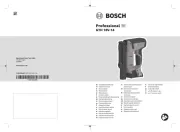
16 September 2025
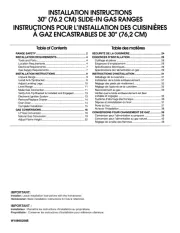
10 September 2025
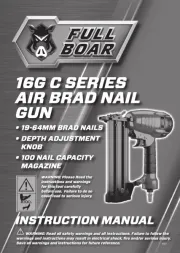
2 September 2025
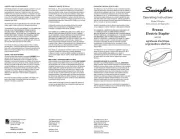
2 September 2025
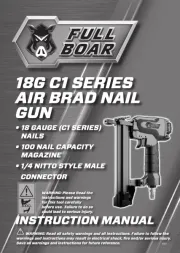
1 September 2025
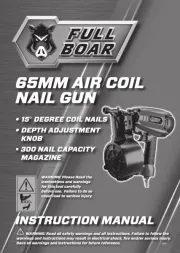
1 September 2025
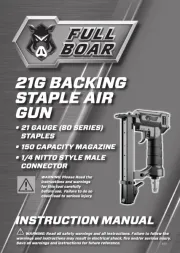
1 September 2025
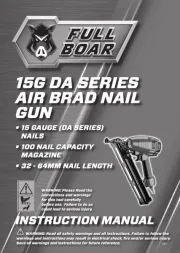
1 September 2025
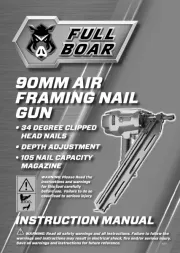
1 September 2025
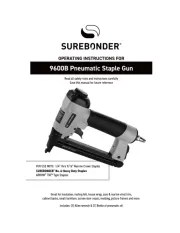
26 Augustus 2025